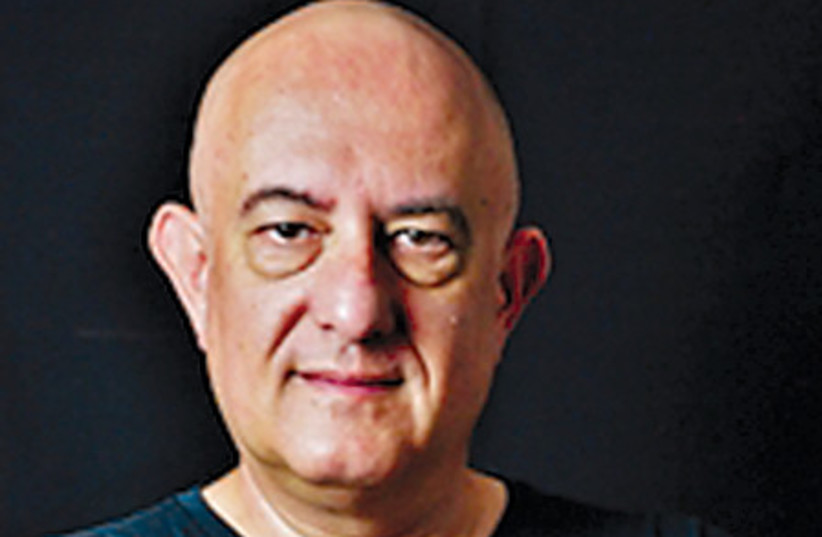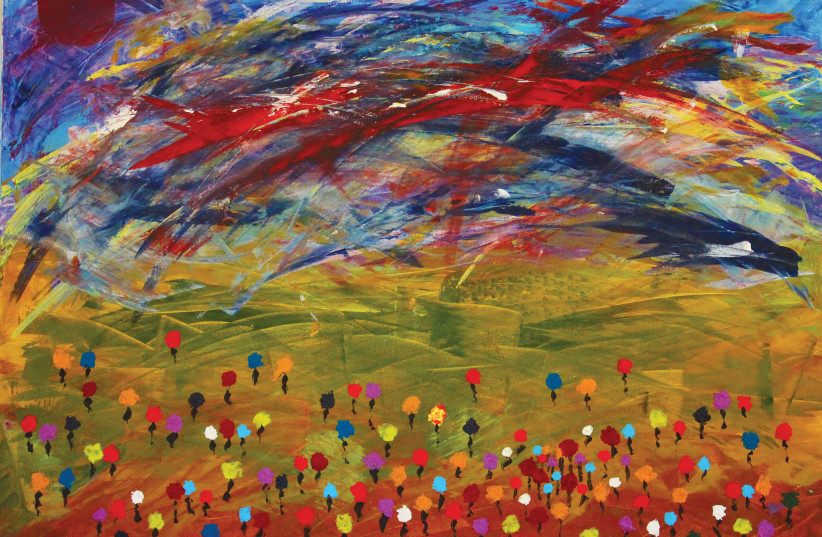Romanian-born Haviv Hauspeter is a self-taught artist, which in itself brings freshness and certain courageousness into his art. As a child, he would draw in pencil and discover the great artists of the past. This motivated him to take up art later in life. By profession, he is an accountant, a field of endeavor often thought to be the polar opposite of that of art. Yet embracing both aspects of self, Haviv straddles the boundaries between the conscious realm of analytical thought as well as the murky sub-conscious and free self-expression that characterize art and art-making.
He is adept at both painting and photography. In the case of the latter, his work is more figurative and literal as he explores with the camera – even a cell phone camera – the ephemeral and transient, capturing “snapshots” in the continuous steam and unfolding of life or as life manifests. Yet it is his paintings that are most intriguing.
Titles of his works, such as Restricted Freedom, Cheerful Gloom, Happy Tears and so on convey the sense of living in paradox, not necessarily a contradiction. That is to say, the human capacity to hold or bear opposites, to unite the seeming contrary within one and the same inchoate impression. One might term this a wise heart, insofar as extremes merge at the boundary so that deep sadness may also be heightened ecstasy, and depth of heart or tears might express profound joy and so on. But it is not in the titles and words that such sentiment is expressed: Haviv does so through subtle sensitivity to color, a stringy line that plays and swirls, fuses with other lines and then separates again.

Allowing the soul and emotions to paint
In discussion with the artist, he explains that he does not illustrate an already well-planned “picture” and then laboriously executes that. Instead, he allows the flow and inner being – call it soul – to express freely as the moment envelops him and the abstract language is most attuned to this emotional outburst. He recalls Kandinsky as a major influence.
As is well known, Kandinsy wrote a famous work entitled Concerning The Spiritual in Art, in which he explains or rather describes how line and color – the very elements or language of art, its grammar – have a correspondence to human feelings and may articulate ideas in the process, such as that of base feelings, the sensuousness of nature, the sublime, even the infinite. Kandinsky is often dubbed the initiator of abstract art in the West at the turn of the century, which was thus taken further by others culminating in Abstract Expressionism especially as it took root in America.
Haviv draws from such a tradition, experimenting with the medium itself and allowing “it” to convey its own rich language, the artist a mere conduit that facilitates this process.
In a sense then the “medium is the message,” so that rather than construct a narrative in the work, one should derive pleasure from it in purely abstract and aesthetic terms akin to the play of sound, the aural world, which is abstract and transcends a literal description.
The artist skillfully uses acrylic primarily in the augmenting of such realm or worlds. Moreover, the artist is open to multiplicity in interpretation, and acknowledges that his dynamic sense of movement and color will obviously be met with various interpretations, as the viewer brings to the work his/her own set of influences, artistic background and emotional-intellectual make-up, as it were.
Even a cursory glance at his paintings will yield the obvious influence of Jackson Pollock. Though not as wild and on a smaller scale, the tumult of energy is apparent as linear motifs and energy points swirl in fields of dynamic tension, yet controlled enough to reveal pattern, order and harmony – an aesthetic of intense pleasure in the act of art-making.
Such exuberant energy also reveals that although there is great complexity, there is yet points of connectivity and an enduring cosmos. Complexity itself reveals an algorithm, like chaos theory or the indeterminate and probabilistic realm within the field of quantum reality. It is as if one were peering into the subatomic realm where a dance is visible as minuscule elements whiz past at incredible speed, each with its own charm, force and creating or magically conjuring a field of some kind. Indeed, evident is point-like particles and wave-like properties or strings, and in some instances – a la Rothko – field-like properties, areas of space and vibrations expressed by strong blocks of color, yet never flat and inert.
Haviv has had the honor of exhibiting at the Agora Gallery, in Chelsea in Manhattan in 2015, in addition to several significant exhibitions here in Israel.
He is currently showing a body of work at the Frishman Gallery in Tel Aviv, where he is exhibiting 20 paintings as well as photographs. His photographic work focuses on architectural dimensions in relation to people in the street. His idea, so he tells me, is to create a snapshot of a particular moment – to arrest time within the constant clamor of life – and to acknowledge the very aesthetics of life itself in the process, through the apparently static image.
The exhibition is entitled Kaleidoscope, which is quite appropriate considering the artist’s work appears to capture the changing effects of light and movement in a dynamic dance, if you will, at once static and yet ebbing and flowing in the chance-like indeterminate realm of being and becoming.

Haviv further reiterates that he sees himself as a traveler, an explorer with the desire to constantly learn and grow. This is expressed in his work, I believe, in the constant search for harmony and order, and the swirl of gesture and emerging areas of light and shadow. I especially like that Haviv can merge the “accountant-self” and the “artist-self.”
I believe such an example is an exemplar of the self as a whole, that is to say, integrating the different aspects of self without neglecting what is truly human, namely the creative, allowing explorations into consciousness that allows for free hermeneutic activity, daring explorations with the artistic medium, and seeing whether that may lead to one’s own unique language, a visual language that transcends words, even concepts.
In this respect, the exhibition promises to motivate and inspire, and is a necessary step in inviting us all to experience ourselves as artists and through materials, rather than a limited field of vision that follows in serial order, in a deterministic and expected set of premises and conclusions. Indeed, it is the possibility of that which is as yet to be conceived that makes life interesting, and that art itself may give us a mere glimpse, an intuition, of the ineffable mystery of existence itself. ■
Haviv Hauspeter’s exhibition extends from August 2 to September 30 at the Frishman Tower, 46 Frishman Street, Tel Aviv. https://www.artavita.com/artists/11756-haviv-hauspeter
